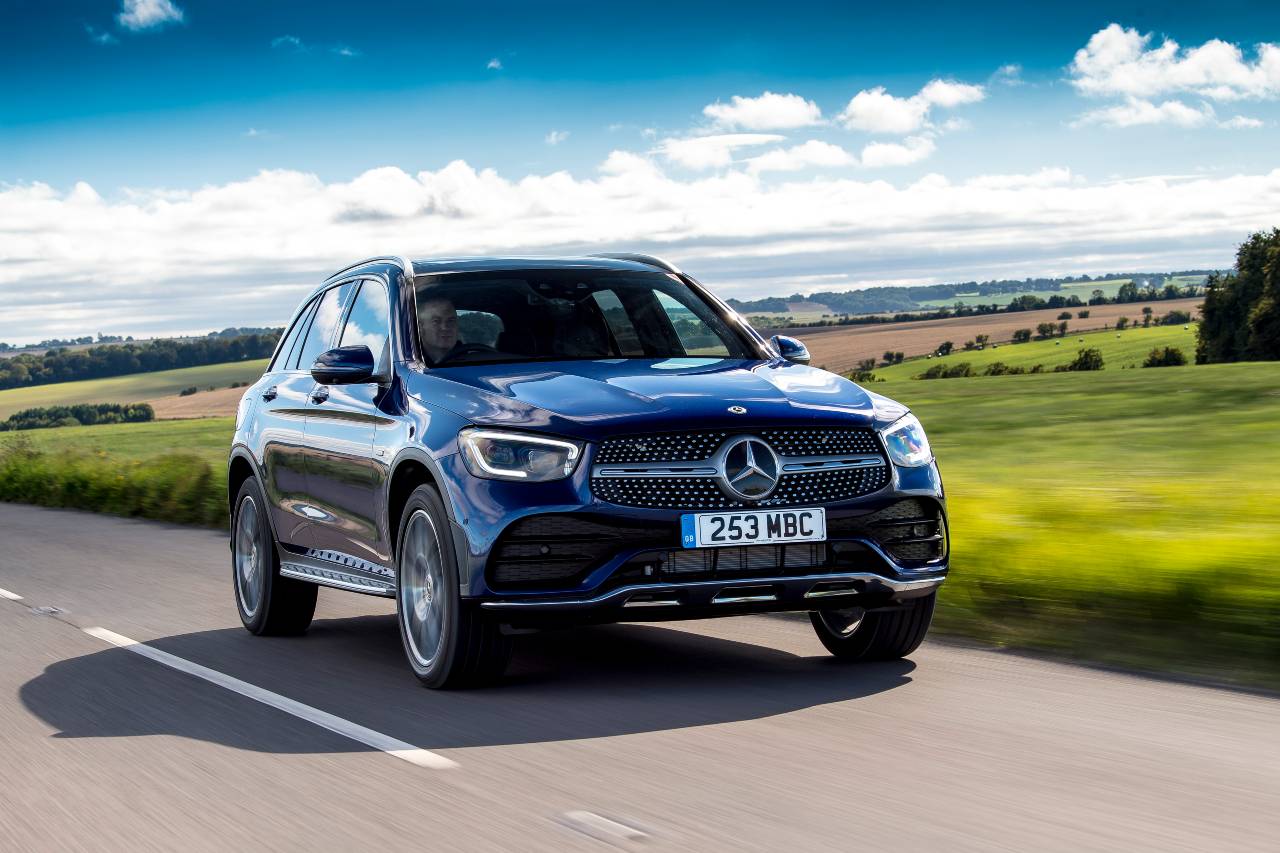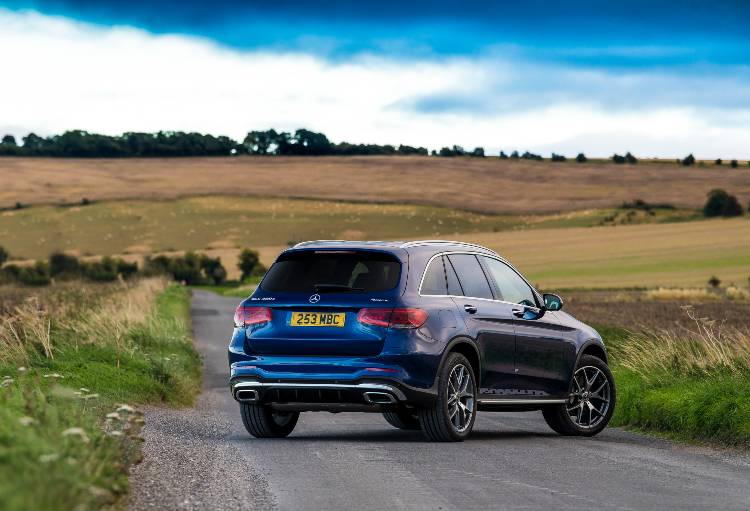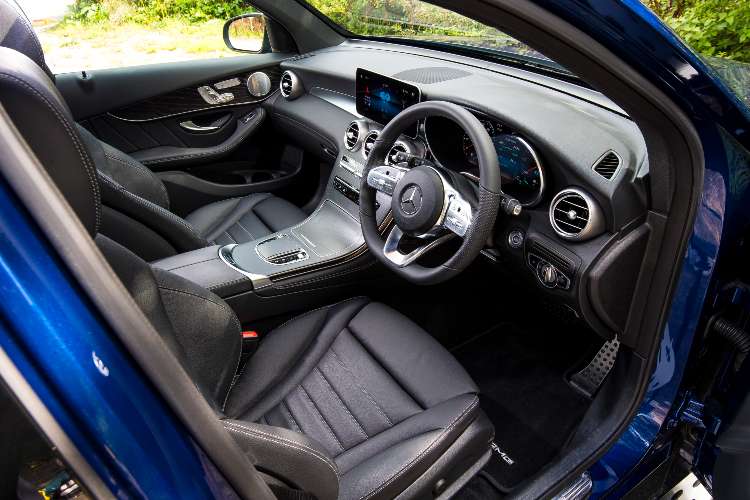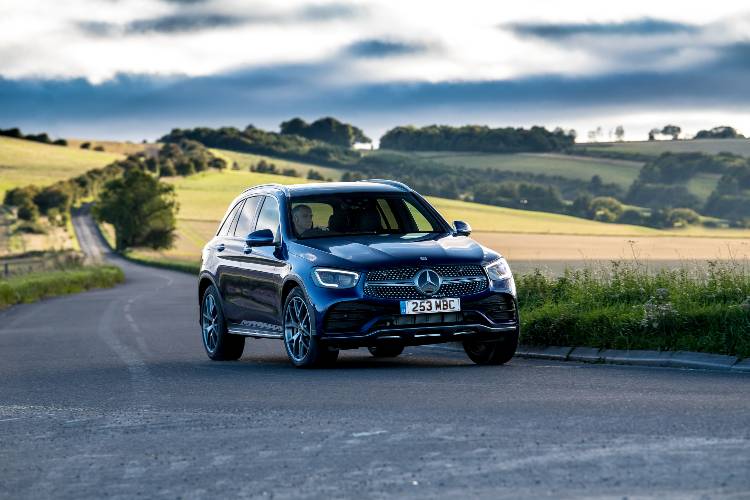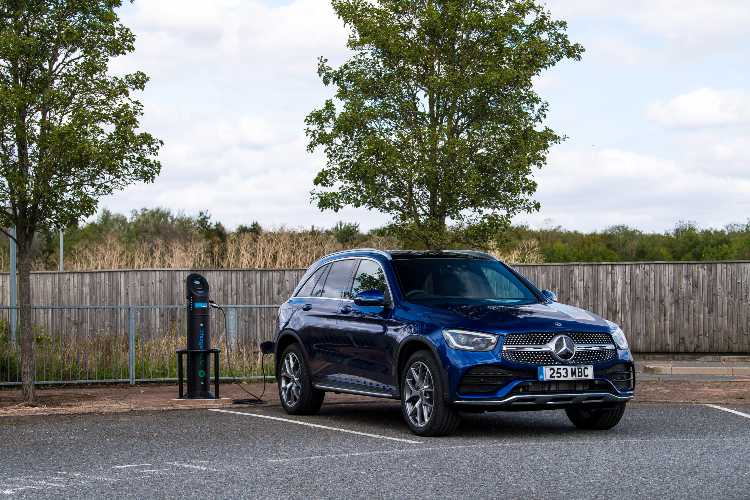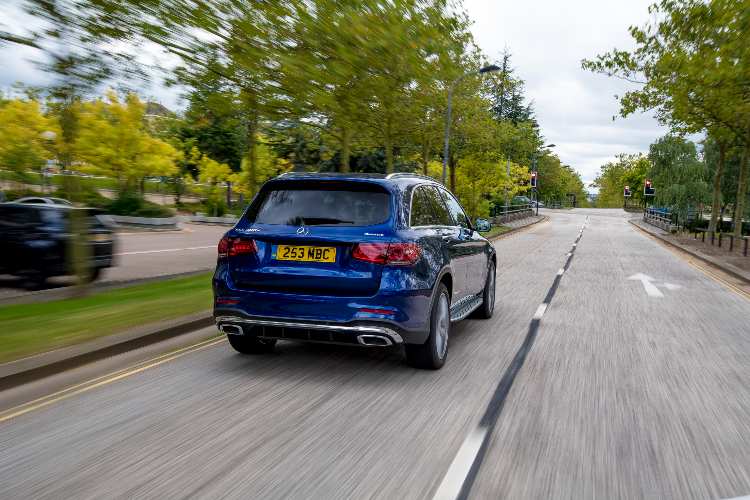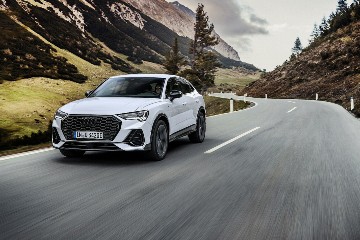What Is The Mercedes-Benz GLC?
The Mercedes-Benz GLC is a midsize premium SUV. This follows the German company’s 2015-on convention of giving all its SUVs a ‘GL-’ nameplate (for ‘Gelandewagen’, the German for ‘all-terrain vehicle’ and a nod to the long-serving, boxy G-Class) and then suffixing it with a letter that ties it in with a similarly sized car from Merc – so the GLA is the A-Class-sized SUV, the GLE is the E-Class-sized SUV and the GLS is the S-Class-sized SUV. Thus, the GLC is best considered as a high-riding, bigger-bodied C-Class.
This convention has carried over into Mercedes’ latest line of all-electric models, some of which are SUVs too – so the EQA is basically a GLA without an engine and with some slightly different front-/rear-end styling. Similarly, if you want to go all-electric, then consider an EQC lease. It's a large, premium electric SUV that is basically a GLC with some full-width light strips at both ends of the vehicle and streamlined, aerodynamic bodywork.
The GLC has been around since very late 2015 and it replaced a chunky, square-rigged SUV called the GLK in the Mercedes portfolio, although we never got the GLK in the UK, even though it was sold widely in continental Europe. Therefore, the GLC can be considered Merc’s ‘first’ SUV in this class – which is to say the GLC has been designed to compete with the likes of the Alfa Romeo Stelvio, the Audi Q5 and Q5 Sportback, the BMW X3 and X4, the Jaguar F-Pace, the Lexus NX, the Maserati Levante, the Porsche Macan, the Range Rover Velar and the Volvo XC60, primarily. Although you could say, for example, that a nicely specified Volkswagen Tiguan could match up to it, as well.
Mercedes offers the GLC in standard SUV format, with 5 doors and an upright rear tailgate, or in a swoopier, coupe-like body which it calls the GLC Coupe. This still has 5 doors, though; it just has a slightly less capacious boot, which we shall come onto later in the review. Both versions come with a choice of 4-cylinder petrol or diesel power, and then a choice of 2 plug-in hybrid (PHEV) drivetrains as well – these are based on the existing internal combustion engines, with a petrol-electric model offered and then (unusually in the wider modern-day PHEV world) a diesel-electric variant too.
All mainstream GLCs are 4-wheel drive (badged 4Matic) and equipped with a 9-speed 9G-Tronic automatic transmission as standard, while they are sold in 3 main specifications: AMG Line, AMG Line Premium and then AMG Line Premium Plus. The 5 main drivetrains available (220 d, 300 d, 300, 300 e and 300 de) can be specified in both body styles, so choosing your GLC should be a really simple process.
And if you want something a bit more potent than a 4-cylinder engine? Well, Mercedes-AMG has you covered. It does 2 different flavours of go-faster GLC, these being a V6-powered ‘43’ and an outrageously naughty V8-powered ‘63 S’. Again, these 2 are 4Matic AWD and they have 9-speed automated transmissions, but they are slightly different gearboxes to the main range – the 43 uses an AMG Speedshift TCT (twin-clutch) unit, while the 63 S has an AMG Speedshift MCT (multi-clutch) ‘box. They are also, just like the 4-cylinder models, sold as both SUV and Coupe GLCs.
What’s Good About The Mercedes-Benz GLC?
Much of the Mercedes-Benz GLC is finished and engineered to a very high standard. There are sportier SUVs in this class to drive – the Alfa, BMW and Porsche, in the main – and perhaps ones which have even finer cabins than the Merc (we’re thinking of the Volvo XC60 here), but in general the GLC is excellent in most areas and notably weak in none, really.
For starters, it’s a good-looking machine, even as the Coupe – a style of SUV body which is not universally loved in the petrolhead community – and a midlife facelift in 2019 kept it fresh in the face of younger competitors. Similarly, the interior is high-quality and has a good blend of useful technology along with decent, intuitive ergonomics. As an effortlessly stylish family machine, it passes the showroom test with flying colours, making GLC leasing a popular option.
You can choose from 10 varied paint colours, including 2 notably special "Manufaktur" coats. Read our Mercedes GLC colour guide for more details on paint and interior options.
What Could Be Better On The Mercedes-Benz GLC?
For all the brilliance of the interior in general, the GLC is starting to show its age in terms of the human-machine interface. The 2019 update did bring in the Mercedes-Benz User Experience (MBUX) infotainment software, which allows you to interact with the SUV’s technology simply by saying ‘Hey Mercedes’ and then using voice commands.
That said, the base-spec AMG Line has a 10.25-inch floating infotainment screen, whereas newer Mercedes models have the more neatly integrated Widescreen Cockpit digital array, and it also comes with just a 5.5-inch multifunction display in the instrument cluster. You therefore need to step up to AMG Line Premium or higher to enjoy the configurable 12.3-inch TFT screen behind the steering wheel, in order to get the maximum ‘tech wow-factor’ from the GLC.
What Is The Mercedes-Benz GLC Like To Drive?
While the GLC, even as the supposedly sportier Coupe, does not have the most vivacious chassis in the world, the handling is not bad for a large, heavy, tall vehicle like this. Grip levels are high and the steering is reasonably communicative, so the Mercedes is adept in the corners, even if it’s not startlingly enjoyable.
Where it really earns its spurs is in the ride and refinement department. Even the regular models, on their fixed-rate Sport suspension, have impressive levels of comfort both around town and out on the motorway, while layers and layers of sound-deadening around the passenger compartment ensure that the interior of the GLC is hushed and subdued when driving at higher speeds.
The engines are good, too, now that Mercedes has finally dispensed with its noisy old 2.1-litre turbodiesel and replaced it with a smoother, more dignified 2.0-litre unit. This comes as the 194hp/400Nm 220 d on all 3 main trim grades, or as a more potent 245hp/500Nm 300 d for AMG Line Premium and Premium Plus GLCs only. The solitary pure petrol, again available across all 3 specifications, is the 300 (no suffix letter), which has 258hp and 370Nm, plus 14hp of EQ Boost mild-hybrid technology to help it along.
For the PHEVs, the GLC 300 de takes the 220 d’s engine and adds a 90kW (122hp)/44Nm electric motor, giving a combined peak output of 306hp; slightly less than the combined 316hp the 2 propulsion systems make individually. It’s a similar story for the 300 e petrol, which has a 211hp 2.0-litre petrol and the same 90kW electric motor, resulting in 320hp overall.
Both of these powertrains obviously only improve the general high-speed refinement of the GLC, as they can run in engine-off electric-only mode for periods of time (providing they have sufficient battery power), but all the hybrid technology adds weight to the Mercedes SUV, which slightly degrades the quality of the low-speed ride. It also requires certain practicality sacrifices, which we’ll come onto later in the piece, so think very carefully before choosing the 300 e/de models.
If all of this sounds a touch underwhelming, you’ll be wanting 1 of the AMGs. The GLC 43 is a twin-turbo V6 3.0-litre petrol, making robust outputs of 390hp and 520Nm from its petrol engine. This means it can run 0-62mph in just 4.9 seconds and has to be limited to a top speed of 155mph, while its standard-fit AMG Ride Control air suspension with continuously adjustable damping only improves both its comfort levels and its handling attributes. The AMG GLC 43, available in both Premium and Premium Plus specifications, is more than enough rapid SUV for anyone’s needs.
Despite that, the flagship is the GLC 63 S. This is a huge amount of money more to lease than any other GLC, the 43 included, and it’ll also empty your wallet at a hugely accelerated rate as well, but then you do get a 4.0-litre biturbo V8 engine making 510hp and 700Nm to play with. This makes the 63 S ferociously fast, with a 0-62mph time of 3.9 seconds only telling half the tale of the viciousness of its acceleration, and as the ultimate GLC AMG comes only in a high-grade Night Edition Premium Plus specification alone then you get a speed-limiter raise to 174mph in the process.
The GLC 63 S is almost best considered as an animal apart from the rest of the range – it makes a terrific din from its V8 engine, the handling is far more sports-car-like than SUV-esque, and it’s a riot to drive for such a big machine. That said, it’s not for the faint-hearted, so a better all-round choice will probably be found lower down the GLC hierarchy.
How Practical Is The Mercedes-Benz GLC?
All GLCs can comfortably seat 5 adults, although the footwell in the centre-rear seat is compromised by a sizeable transmission tunnel. That’s not a failing of the Mercedes in particular, as most 4-wheel-drive SUVs are saddled with the same thing, but we have to mention it nonetheless. Elsewhere, the cabin is replete with clever storage solutions, as well as a plentiful array of nooks and crannies and cupholders and so on, so practicality is not an issue in general. Visibility is also good in all directions in the regular GLC, although the Coupe’s sloping tailgate hatch results in a letterbox-type rear screen, hindering the driver’s view out when reversing.
The Coupe also makes compromises in terms of boot space, even if headroom in its 2nd row is largely on a par with that found in the normal GLC SUV. The rated boot capacity of the Mercedes is 550-1600 litres on the 5-door model, with the Coupe losing 50 litres seats up (500 litres) and a notable 200 litres (1400 litres maximum) with the rear seats folded away.
However, the PHEVs savage the cargo bay even more, due to the placement of the battery and other hybrid ancillaries. A GLC SUV PHEV has a 395-/1445-litre boot, depending on whether the back seats are in use or not, while the GLC Coupe PHEV sees those numbers fall to 350 and 1250 respectively. That’s about the same size as a Volkswagen Golf-class hatchback, so it’s not a very impressive set of numbers.
How Much Will The Mercedes-Benz GLC Cost Me?
Sold only in AMG Line and grander specifications, and coming with that 3-pointed star on its grille, the Mercedes GLC is not exactly cheap to lease. With list prices starting at around £45,000 for the SUV and £49,500 for the Coupe, it’s an expensive vehicle and that translates to leasing costs of around £500-£670pcm with Vanarama for the non-AMG versions. However, it’s comparable to similar Audi, BMW and Volvo rivals, so if you like the GLC and you have the budget, it’s still competitive in its class.
Simply put, going from an SUV to an equivalent Coupe model of GLC will add about £3500-£4300 to the overall price, depending on spec, while the price walk from AMG Line to AMG Line Premium is £2800, while AMG Line Premium to AMG Line Premium Plus requires another £3750.
For that, the AMG Line GLC comes with 19-inch alloys, 3-zone Thermotronic climate control, LED high-performance headlamps with adaptive high-beam assist, Parktronic sensors at both ends of the vehicle and a reversing camera too, the MBUX multimedia system, heated front seats, leather upholstery, a 3-spoke multifunction Sports steering wheel, AMG exterior styling and a diamond grille, among much more. The Premium adds the 12.3-inch digital instrument cluster, 20-inch alloys, exterior running boards and 64-colour ambient cabin lighting to the mix, while the Premium Plus takes all of this and further loads twin-spoke 20-inch wheels, a panoramic glass roof (on the SUV, it’s a tilt-and-slide electric sunroof on the Coupe), Keyless Go entry and start, a memory package for the seats, and a parking package with a 360-degree camera system.
The AMG models are another level again. The 43 is quite well priced, from £56,775-£61,070 as an SUV and £60,230-£64,525 as a Coupe, and given their Premium and Premium Plus specifications add in 20-inch AMG alloys, an AMG Performance Exhaust, beefier AMG body styling, AMG Ride Control Air Suspension and twin-exit exhausts to the already-generous equipment levels – as well as the added power, performance and handling – then that premium doesn’t look too hefty. Bear in mind, though, that leasing costs will be nearer £700pcm, or even beyond that figure, for the 43.
The 63 S is vastly more expensive again, however. It costs from £94,785 as an SUV and £97,960 as a Coupe, reflecting the huge upswing in dynamic ability it represents. Its Night Edition Premium Plus kit list takes everything you’d find on the next-highest-grade of GLC and further bolsters it with 21-inch forged cross-spoke AMG alloys, an AMG Night Package of exterior detailing, red brake callipers, various interior AMG accoutrements (more shapely front seats and an AMG steering wheel being the principal items), and the aforementioned increase in the vehicle’s limited top speed from 155- to 174mph.
In terms of running costs, the winners are the PHEVs. They’ll only emit from 48-55g/km of CO2 as the 300 de, and 52-59g/km as the 300 e, meaning they’ll be best for benefit-in-kind taxation purposes, and the fuel economy is claimed as between 108.7-122.8mpg for the petrol-electric 300 e and 134.5-156.9mpg for the diesel-electric 300 de. We always sound caution with those miles-to-the-gallon numbers on PHEVs, though, as to attain them you’d need to regularly plug the Mercedes SUVs into the mains and make best use of the 25-28 miles of all-electric range they claim to offer on a daily basis.
Beyond that, the 220 d and 300 d models will gift between 40- and 46mpg, with CO2 of anything from 159- to 184g/km (depending on which engine, trim spec and body type you go for), while the 300 mild-hybrid petrol is said to achieve 33.2-34mpg WLTP combined, with 188-191g/km of CO2 emissions.
The AMG variants will be the costliest to live with. The 43 does 25.2-26.2mpg on the official combined cycle, with accompanying CO2 numbers of 244-254g/km, while the monster 63 S does 21.7mpg and pumps out up to 290-295g/km of CO2. Only go for this V8 beast if you have very deep pockets, then.
Anything Else I Should Know About The Mercedes-Benz GLC?
The PHEV models lose boot space compared to their stablemates and they also have a smaller fuel tank fitted. Where other versions of the GLC have 66-litre fuel tanks, the items fitted to the 300 e and 300 de are scaled back to just 50 litres overall.
What Alternatives To The Mercedes-Benz GLC Should I Look At?
Audi Q5 Leasing
The Q5 comes in 2 body styles, like the Merc, and also like the GLC it favours comfort over outright excitement.
BMW X3 Leasing
The X3 is a natural alternative to the GLC and very talented in the corners. you can read our GLC vs X3 article for more detail on how these 2 compare.
Volvo XC60 Leasing
The XC60 has a glorious interior, plug-in hybrid options galore and sultry Swedish styling.
The Vanarama Verdict: 8/10
"A big, well finished, refined ride."
Three Things To Remember About The Mercedes-Benz GLC:
-
It’s an incredibly refined and luxurious family SUV
-
There are 2 plug-in hybrid choices for you, including a rare diesel-electric model called the 300 de
-
There are also 2 wild AMG versions, topping out with a 510hp, 174mph GLC 63 S
For more articles, you can check out our car features and guides section. Or if you're looking for a brand new vehicle, we've got a huge range of cars to lease at unbeatable prices.

